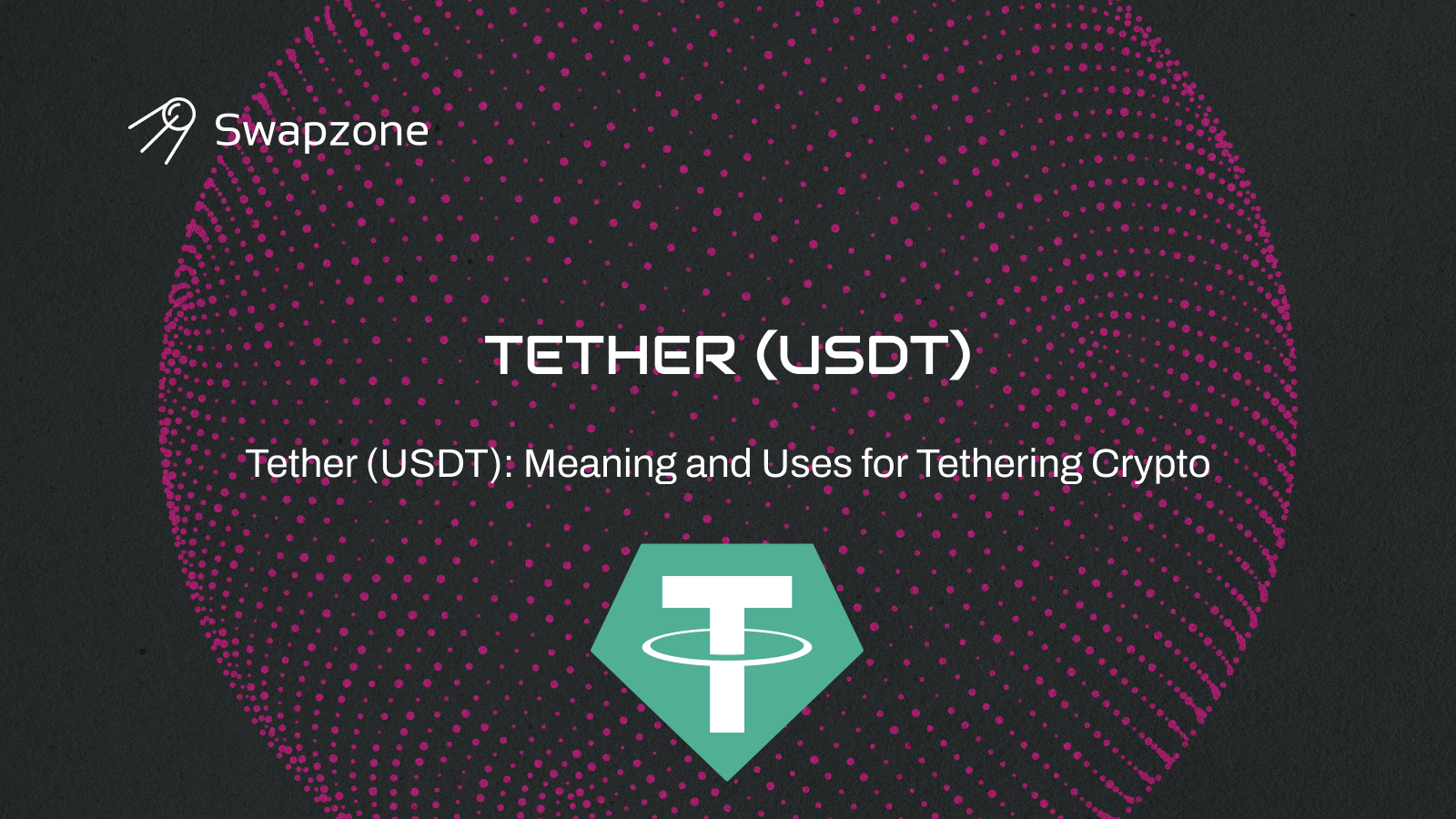Picture a situation where the value of your online assets can remain buoyant despite the fluctuations in the price of cryptocurrency. That’s where Tether (USDT) comes into play, as it is a cryptocurrency tied to the US dollar. Being one of the foremost stablecoins, USDT balances the steadiness of fiat money and the advantages of cryptocurrencies. In this article, the reader will learn what Tether is, its function, and its place in the crypto world.
What is Tether (USDT)?
It is important to understand that tether (USDT) is a type of stablecoin, a cryptocurrency whose price is designed to stabilize by being ‘tethered’ to a reserve asset, usually a fiat currency, such as the US dollar. Specifically, each Tether token is supposed to be worth one USD, which allows for obtaining all the benefits of cryptocurrencies, excluding the high volatility of the rates. This stability is important for trading, remittances, and DeFi, among other uses.
The System Behind Tether
Tether works on a fairly simple system. This means that for every USDT received, an equivalent USD is retained in circulation. This guarantees that users can always redeem their USDT for fiat currency at a 1:1 ratio of teachers for every 60 students. The process functions as follows:
Issuance and Redemption: When buying USDT, Tether Limited, the company behind the token, creates a new token equivalent to the amount of USD received. Similarly, users can sell back the USDT and get USD in return. When redeemed, the USDT equivalent of that particular NFT is burned permanently out of the circulating supply. This, in turn, guarantees that the same fiat currency value backs the USDT in circulation at any given time.
Audits and Transparency: The parent company of Tether, Tether Limited, believes that it conducts audits frequently to ensure that it holds an equivalent amount of USDT to that in the market. Transparency is important because it helps ensure that people have confidence in the stability of the particular stablecoin. The more frequent and comprehensive the audits are, the more one can be sure that the circulating USDT is backed by reserves, thus increasing people’s trust.
Uses of Tether (USDT)
Tether (USDT) is popular in cryptocurrency because it has a stable price, high volume, and transparency. Here’s an expanded look at the various functions of USDT:
Trading
Another major use of USDT is in trading other cryptocurrencies. The rationale behind Tether is to serve as a stable value where traders can easily switch between it and other highly volatile cryptocurrencies without necessarily transitioning to fiat money. This practice is commonly referred to as ‘tethering,’ and it offers the trader insurance against changes in the market. For example, during a trading downturn, a trader will sell Bitcoin for USDT to retain their capital’s purchasing power. They can get into their Bitcoin position again when the market becomes stable, which is the key factor behind it.
Remittances
However, the article has revealed that using Tether can be effective in cross-border money transfers. Common sending practices involve high costs, which are in the form of service charges and time consumption. USDT has the added advantage of being faster and cheaper to transact compared to the traditional banking systems in the current world, especially in the developing world where banking is not easily accessible. In essence, people can transfer USDT from one country to another in minutes with little or no transaction costs compared to the time and costs of banking and remittance services. This is an ideal option for transferring money worldwide in the shortest possible time and with minimal fees.
Decentralized Finance (DeFi)
Tether cannot be overestimated in the world of DeFi, which continues to grow. DeFi platforms offer financial services such as the provision of loans, borrowing of funds, and getting interest on invested assets without the involvement of intermediaries. USDT is stable and has some advantages compared to other cryptocurrencies, so it is often used on these platforms. In Aave or Compound, for example, borrowers can deposit their USDT and earn interest or use USDT to borrow funds against their digital assets. This enables them to engage in some of the financial activities that were previously the preserve of the banking sector, extending the financial services available to people.
Payments for Purchases of Goods and Services
USDT is slowly but surely being accepted by more businesses. This is due to its stable value, which is ideal for merchants who don’t wish to deal with the fluctuating prices of other cryptos. For instance, a freelance graphic designer may work with different clients who pay in USDT, which helps them receive a stable value for the money they deserve. This lowers the risks attached to the volatile exchange rates and gives a sure-shot method of making receivables.
Tether or USDT has several advantages that make it ideal for cryptocurrency users. Let’s examine these benefits in detail:
Stability
The main advantages of Tether are its stability and ability to free up capital for other ventures. A stable asset is needed in cryptocurrencies, where most still fluctuate after creation. Tether achieves this by pegging its value to the US dollar on a 1:1 base. For example, a researcher may have a hypothesis based on a one-base concept of a particular phenomenon. This stability is crucial for several reasons:
Hedging Against Volatility: Tether makes it easier for traders and investors to hedge their positions against market fluctuations. When the prices of various assets fluctuate, they can sell them and convert them into USDT to retain their value.
Stable Store of Value: Tether provides the reliability of holding cash and lets users avoid cryptocurrency volatility without selling their cryptocurrency investments. It enables users to have their funds within the ecosystem and exempts them from the risks associated with other crypto assets.
Liquidity
The USDT is one of the most highly liquid cryptocurrencies in the market, and it has high volumes of trade on various platforms. Liquidity is the level of transparency for an asset so that it can easily be sold or bought without hurting the price of the asset. Tether’s high liquidity offers several advantages:
Ease of Trading: High liquidity implies that users can easily convert their USDT to other coins or sell them with little or no effect on the prices. It is particularly valuable for large orders executed by various traders without drastically shifting price levels.
Efficient Conversion: Tether’s high liquidity makes It easily exchangeable with other cryptocurrencies or fiat currencies. That flexibility can benefit anybody who wants to transfer funds from one asset or platform to another.
Accessibility
Tether is a relatively centralized cryptocurrency utilized on many platforms and exchanges. This widespread acceptance enhances its usability in various financial activities:
Universal Acceptance: USDT is versatile for trading on a large exchange or a DeFi platform. This global adoption makes it easy to incorporate Tether into your operations and adapt to the ever-evolving financial sector.
Cross-Platform Integration: Tether, as an ERC-20 token, can be utilized in various blockchain platforms, such as Ethereum, Tron, and Omni. Its cross-platform compatibility enables users to use Tether in different blockchains, thus increasing its opportunities.
Cost-Effective Transactions
Using Tether for transactions can be more cost-effective compared to traditional banking and financial services:
Lower Fees: Making a transfer with Tether is sometimes less expensive than wire transfers or conventional payment gateways. This cost-efficiency is even advantageous in today’s global economy since other modes of payment are often costly.
Fast Transactions: They noted that Tether transactions were fast and completed within a few minutes. This is especially helpful for time-sensitive payments and remittances; it offers quicker financial services than traditional methods.
Security
The underlying blockchain technology is used to secure tether transactions. Each transaction is recorded on a public ledger, ensuring transparency and reducing the risk of fraud:
Blockchain Security: In this paper, Tether embraces the cryptographic security and decentralized validation implemented on the blockchain. This makes it complex for anyone with ill intentions to change the transactions’ records or develop fake tokens.
Transparency and Audits: The management of Tether Limited states that the company has independent examinations to confirm that the sums of USDT outstanding correspond to its funds held in reserve. As for some controversy over the openness of these audits, an additional check by the independent auditor can be considered an important guarantee.
Practical Use Cases
To understand the real-world benefits of Tether, let’s examine some practical use cases:
Trading and Arbitrage: Buyers employ Tether as a convenient tool to shift between various cryptocurrencies in response to temporary imbalances between the rates of multiple platforms. This practice, called arbitrage, needs a stable asset, such as USDT, to limit the risk of losses.
International Remittances: Migrant workers can also use Tether to send money to their home countries. The high speed of transactions and the possibility of making payments at a lower cost than services using traditional methods of transferring funds make USDT a popular means of payment in cross-border operations.
Merchant Payments: Companies operating online platforms can integrate Tether as an accepted payment form. This enables them to explore the increasing market of cryptocurrencies without exposing themselves to the risks involved in the other forms of cryptocurrencies.
Conclusion
Among all the players, Tether (USDT) can be considered the most significant player with a leading role in the ecosystem. Due to its stability and acceptance by most trading businesses and common users, it comes in handy as a basic trade tool. There are still some issues, though the stablecoins’ prospects are bright, and there are a lot of opportunities for development and further evolution. Despite these changes, Tether is expected to be a staple as the crypto market has changed occasionally since its introduction.


